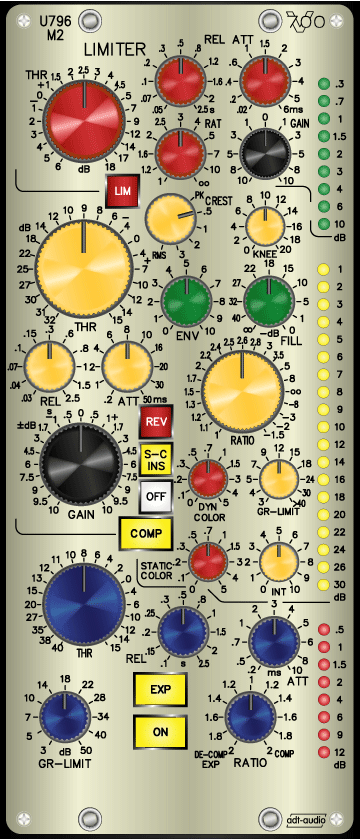 Compressor Compressor
The Compressor section includes a range of additional, uncommon functions that make possible to attenuate negative side effects on the tonal performance of compression. Using program-adapted settings for these controls allow massive loudness gain of more than 10 dB while natural sound performance and transient response are well maintained. The mix just sounds louder but it does not sound compressed. The huge control ranges for all parameters allow a wide range of different settings that include the simulation of almost all vintage gear.
Crest
The Crest control affects the behavior of the ac/dc converter that generates the control voltage of the comperssor out of the envelope of the input signal. The basic character of the compression is mainly determined by this setting. A stepper switch offers the choice to selecting 6 different characteristics; from a fast PEAK conversion that results in a 'hard' compression to a slow RMS conversion that causes a soft and warm treatment. The remaining 4 steps are well dimensioned interim values between these to extremes, which are better suited in most cases than PEAK or RMS.
Envelope
Using the Envelope control makes possible to achieve a clean and precise compression of bass signals. Due to the physical effects of regulation with fast release time settings that avoid audible pumping of the signal, low frequency signals can be distorted. The reason for this distortion is that the regulation starts within the period time of the bass signal. Such a fast regulation results in a deformation of the original waveform. A longer release time reduces the distortion; however, if the release time is longer than the release time of the human ear, pumping up effects appear. Since it is hard to find an acceptable compromize between LF distortion and audible pumping, this effects is one of the most important limitations of the possible gain reduction with real world program material. Higher gain reductions that are necessary to achieve high loudness gain make this compromize a lot harder.
Using Envelope with program adapted settings can reduce low frequency distortion significately without the need to increase the release time and run into pumping problems. It can also avoid pumping modulation of the mix from the kick drum.
The ENV control alters a special filter in the side chain of the compressor section, that reduces the compression in the bass range insignificantly. The filter has a special curve that it optimized for that purpose. This is combined with a slight influence on the release time, which is automatically increased with the remaining low frequency signals that pass the filter. When the low frequency level becomes relevant, the envelope circuitry increases the release time a little as long as the high level bass signal is present. Both effects, filtering and release time modification are well balanced. The combination of the two effects offers a simple setup of the release time and causes a great improvement in the possible gain reduction and loudness gain.
Fill
Low threhsold settings and high values of the ratio result in high gain reduction that will produce a destruction of the fine signal structures. This effect causes also a certain limitation of the possible gain reduction. If this destruction can be covered well, higher compression is possible that will result in higher loudness. Adding the uncompressed input signal of the compressor section to the compressed output can 'fill the holes', caused by the hard compression very well. The original transients are restored and if the level relation of the uncompressed signal and the compressor output signal is well adapted, the loudness gain remains very high while the side effects are drastically reduced. The FILL control has an appropriate control range for this application and is one of the most effective 'weapons' to achieve high loudness.
Soft Knee
The Soft Knee control modifies the transition range around the threshold level. When all to the left, the transisition is hard, which means that any level that exceeds the threshold is compressed to the value that is determined by the ratio setting. Any other setting of the soft knee pot results in a soft approximation of the compression to the ratio value. The control is calibrated in the level difference between the threshold level and the point where the ratio setting is reached. When set all to the right, the level must be 20 dB above threshold before the compression matches the ratio setting. With high values for the ratio, soft knee smoothes the transition range and can result in higher possible compression rates. However, with small ratio values of 2 or less, as they are mostly used with mastering, the effect of the soft knee is less important.
- more Compressor Functions
|


 Compressor
Compressor V700
V700